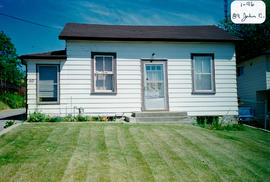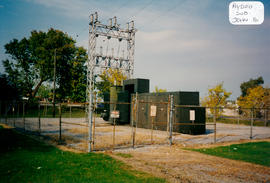- CA BWGPL GJ-HB-2017-04-04-18
- Item
- 1996
Part of George Jackson fonds
The mid-block building located at 89 John St. East is set well back from street. It was built around 1860-1880’s in the Ontario Vernacular Cottage style. John Edwin (or Harry) Cerswell, a retired gentleman, lived here at one time before selling the house. Dave Mundy and Walter moved here from their farm on the 10th line. Dave worked for Holland River Gardens and Walter worked for the Spence Lumber Co. Walter built a garage at the back of the house. When Dave died the house was sold. Years later, a small house was built along the back fence to provide housing for marsh workers. Joe McMillan and his daughter rented it, as did Dick Roberts and Wilma. Lorne Campbell and his wife also lived here after World War II. It was later demolished.
The one-storey, three-bay cottage seen in this photo from 1995 has a rectangular plan with a centre hall. A box hall was typical for this style. It also has a symmetrical façade and a shallow-pitched, gable roof. There is a simple entrance with a single door set into a rectangular opening. It opens directly into the house from slightly above grade level. No porch or weather protection shelters the entrance. The house has small windows with low floor to ceiling heights. There are double-hung windows on either side of the entrance. The 2/2 windows appear to be original. Windows are set into simple, rectangular openings with plain, wood frames and sills. The building has wood frame construction, vinyl siding, a stone-rubble foundation, and a basement with window openings. Originally, the siding was wood. A one-storey addition at the side of house is not original and it has different foundation material. According to the 2000 inventory, this simple cottage probably had few decorative details originally. It notes that other than the building’s form, few existing building elements appear to be original. (1, 2, 3)
George Jackson




